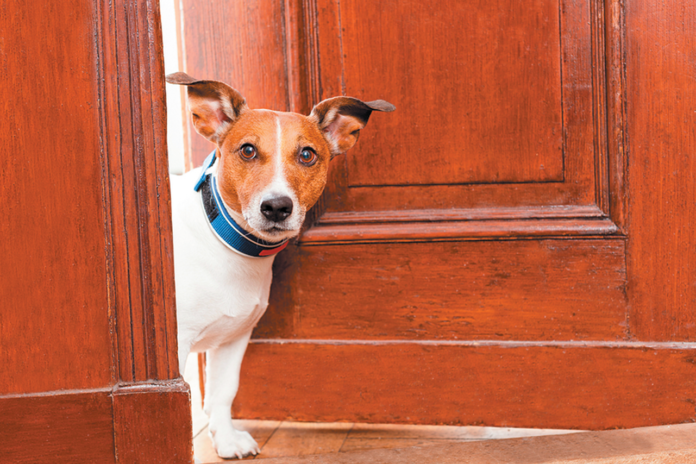Doorbells are intrinsically exciting for dogs,” says the head of the Tufts Animal Behavior Clinic, Stephanie Borns-Weil, DVM. “They signal something is about to happen, so it’s associated with arousal.” Some dogs will even run to the front door when they hear a doorbell ring on television. There are dog owners who can list all the ads on TV that have doorbells and all the episodes of television shows during which a doorbell is rung.
But also, Dr. Borns-Weil says, because dogs are territorial by nature, they know the doorbell ringing means someone is going to come on their property, and “it signals a red alert.” For a fearful dog the reaction can be particularly strong, she says. While confident dogs might wonder if someone is coming over specifically to play with them, a dog who is afraid worries instead that a scary person will be entering who may want to try to pet him even though he doesn’t want that to happen. He will bark and jump around to try to frighten off the “interloper.”
It’s good to keep these two kinds of reactions in mind, the doctor says, because it helps you adjust your own attitude. Your dog’s barking when the doorbell rings isn’t just an annoying noise. He is performing a function — either to greet someone for what he thinks is a play date or to protect himself.
Still, either way, you want to ease your pet out of reacting to the doorbell as if it’s something for him to handle and not you. Visitors do not want to be barked at (sometimes for several minutes), jumped on, or otherwise be reacted to aggressively. And you want to be able to welcome someone peacefully, without having to devote all your attention to calming your dog down. It’s easier to do if your dog is happy when the doorbell rings rather than afraid. But either way, a dog can learn how to stay calm when a visitor signals that he has arrived.
How to start
For dogs who are so excited by the doorbell that they wouldn’t be able to pay attention to your verbal cues, you might want to begin with your pet on leash and a bag of very high-value treats. Leave the door open and have someone ring the bell so the dog can see exactly what’s going on. “That takes the mystery out of it,” Dr. Borns-Weil says.
When the dog finally quiets down, tell him what a good boy he is and proffer a treat. From there you can go to closing the door just a little bit at a time and having someone ring the bell. Apply the strategy randomly here and there until your pet is no longer so intrigued by the sound that signals someone has stopped by.
If you have a digital doorbell, you can also make a recording of it (dogs can usually tell the difference between an actual bell and a recording) and play it intermittently so the dog learns that the ring tone is not always about someone visiting and will calm down about it. You can start by playing the recording softly, then making it louder, then softer again, then louder, and then graduating to the actual bell at the front door. Whichever strategy you employ, always reward your pet for not barking and jumping with a delicious treat and warm praise. He needs to know that there’s something in it for him if he remains calm.
Once your dog has learned to settle down a little at the sound of the doorbell, there’s a four-step process you can follow.
- Stage arranged visits from people and have them ring (or knock) at the front door — once, and only once.
- Say “shush” or “hush” or some other word — again, just once, and only once. Otherwise, the word loses its potency. The dog will learn that you saying the word doesn’t mean he should calm down; it simply becomes a word that keeps getting repeated when he is excited. Dr. Borns-Weil uses the term “thank you.” It’s her way of telling her dog, “Thanks for letting me know. I’ve got this.” In other words, it says to the dog that you will take care of things for him; he doesn’t need to be on alert.Make sure that you say the word with assurance but calmly. Your dog will perceive anything other than calm and controlled as reason to feel agitated.
- Wait. This is the hard part. You have to use your patience to make the desired behavior happen — which is for the dog to cease all the hubbub. Remain relaxed and still after you have given your verbal cue. Don’t pet your dog and don’t gesticulate, and don’t let him know you feel exasperated. He will perceive any of these as clear signs that the doorbell ringing is something to get all hot and bothered about. The dog will finally stop, even if just for a second to catch his breath.
- At the very moment that your dog stops, quickly give him a wonderful food treat and warm praise for complying with your cue — even if you know he’s going to start right up again. (You can use that opportunity to repeat the cue.)
This approach can take weeks. But it has a very good chance of working if you stick with it. Each day must be like the first. You can never lose patience or show any dismay.
For the scared dog
The above strategy could potentially work for any dog. But a dog who feels afraid when the doorbell rings might need additional training so that he can do something to help him feel safe. For instance, you could teach him to run to a room away from the front door so you can toss him a Kong filled with peanut butter or perhaps some frozen yogurt. Some dogs might like to be taught to go to their crates, or to a particular couch or chair. Whatever the solution, it teaches your scared pet that he does not have to stand there and defend himself; something better awaits.
It may take a little longer for a scared dog to get the hang of it. Fear is a pretty potent motivator. Over time, however, the routine should work — your dog won’t feel like a sitting duck as people come in and try to pet him and give him other unwanted attention, Dr. Borns-Weil says. He will not only feel protected by you but also more closely bonded to you.





